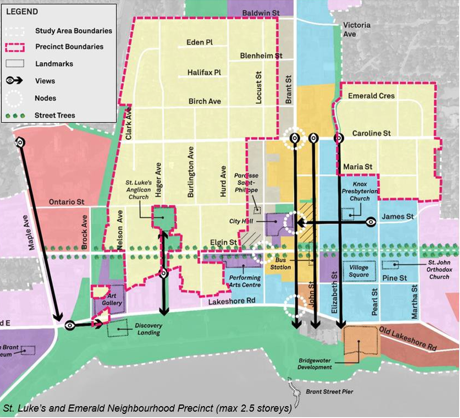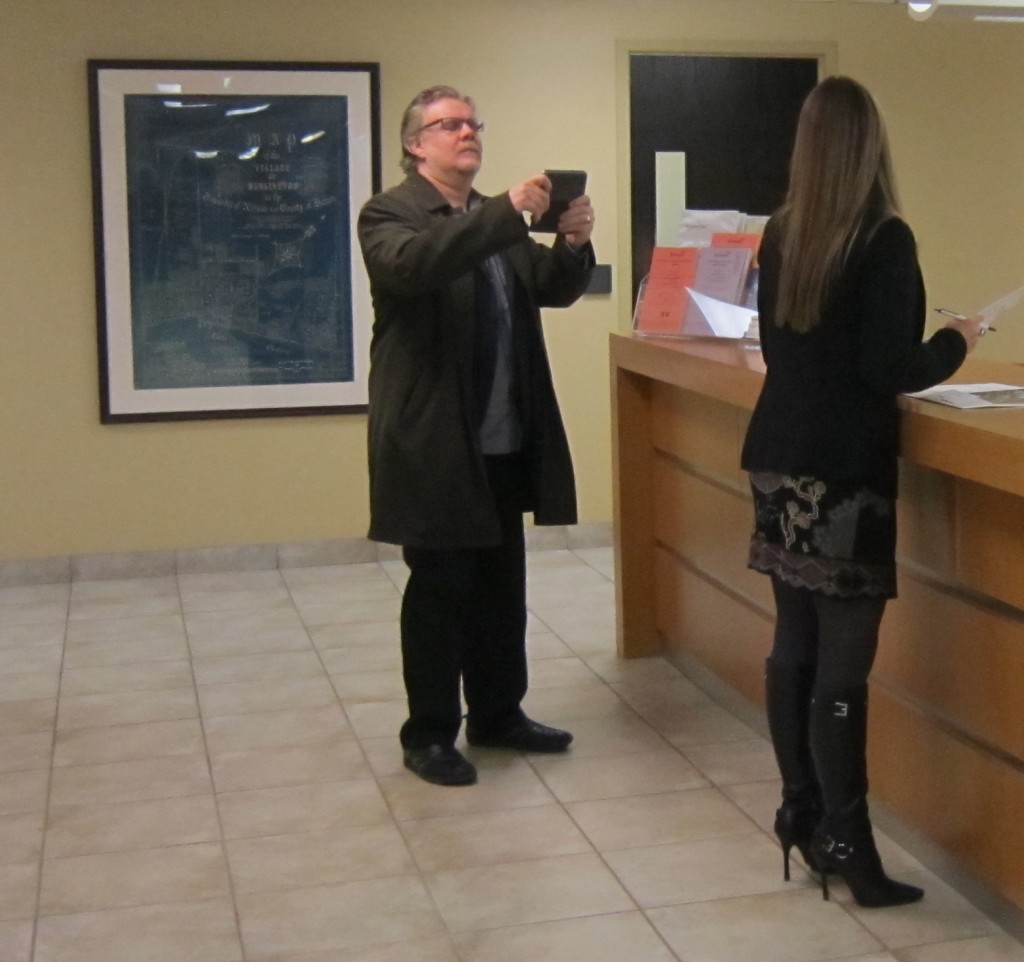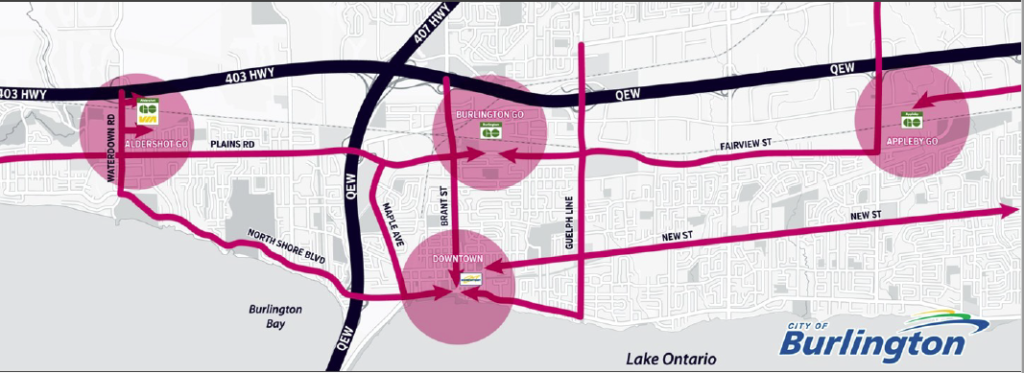 By Marianne Meed Ward
By Marianne Meed Ward
Councillor Ward 2
March 4th, 2018
BURLINGTON, ON
At Planning and Development Committee (P&D) I brought two motions, both lost: one to add the downtown and GO station mobility hubs to innovation districts (currently there is only one innovation district in the OP – the DeGroote School of Business); the second to conduct character area studies for the St. Luke’s and Emerald precincts, as requested by delegates to the P&D meeting. I will be asking for recorded votes on both these items at the March 19 council meeting, and encourage residents to come and speak to them.

The St Luke’s and the Emerald precincts – on either sode of Brant street are solid residential neighbourhoods consisting of single detached homes with good set backs.
At P&D I also asked for additional information on Clause 8.3.3(1)(b) which will permit townhouses and walk-up apartments in all residential low-density single family neighbourhoods. This in spite of the assurances that growth will not be directed to stable neighbourhoods. If that clause stays in, every neighbourhood in the city is affected.
We will be getting additional information on this clause in advance of the March 19 Council meeting, and I will be preparing to bring a motion to strike that clause from the plan.
Any changes made at the March 19 Council meeting, will be included in the final version of the Official Plan when it comes to Committee April 4 and Council April 23 for final adoption. Residents can attend and register to speak at all three meetings (March 19 council, April 4 committee and April 23 council).
It’s worth noting that the three GO station Mobility Hubs are not ready for inclusion in this Plan – yet they will dramatically impact growth in the city: bringing 27,200 people to the Aldershot GO, 22,000 residents to the Burlington GO, and 20,000 residents to the Appleby GO stations. These areas have been under study much longer than the downtown.

Pete Ward recording his wife Marianne filing her nomination papers for the 2014 election. The city clerk advised the Gazette that we were not permitted to take “political” pictures in city hall during an election period.
So why the rush for adoption of the downtown plan? Why adopt an incomplete Plan where major growth areas aren’t included? In addition, delegates to Committee expressed concern that the plan for the GO stations and downtown are just about building buildings, not about building all the community services these new residents need, for example community centres and parks. In response, the city manager suggested that weekly meetings with developers will address that.
For these and other reasons, I don’t support this Official Plan and will continue to work for changes.
Meed Ward made the following comments at the February 28th P&D Committee meeting. Motions approved at the P&D meeting go to a City Council on Monday March 19th.
“I don’t think this Plan is the best we can do for the best mid-sized city in Canada. It’s not visionary. Members of our community, DeeDee Davies in particular, but many others, are challenging us to build community; what we’re looking at in this Plan is building vertical sprawl, and the community hasn’t even weighed in on the Mobility Hubs which will have even more height and density. I suspect that there will be a similar conversation when those three plans come forward as we have had for the downtown.
“Meetings with developers are not going to deliver us the community services and amenities we need in all of those areas including parkland to truly build communities and not just build buildings.
“I am not persuaded at all that adopting this plan in April is going to save us from OMB or Local Planning Appeal Tribunal appeals, and the reason for that is the Adi decision. That decision was argued almost entirely on the basis of what the new LPAT rules are. The new rules require you to conform to provincial policy, and the entire ruling essentially said that the 26-storey building conformed and therefore it was okay.
“That was a wake-up call, that the LPAT is not going to save us and I don’t think us adopting 17 storeys in the downtown core is going to hold at 17 storeys, given that decision.
“The other wake-up call with the OMB ruling was that even though alternative heights were offered – the city offered 11 storeys, another party to the hearings offered 16 – the vice-chair said there was no planning justification for those heights. There was nothing to justify why those were better than 26. And so, in the absence of justification for those heights, she went with 26 because the applicants made a case for it.
“And when I hear delegates coming in front of us saying there’s no planning justification reports of the type that you would see at a hearing that would justify why now all of a sudden we jump to 12 or 11 or 21 or 17 storeys, we are going to be in exactly that same position at LPAT as we were with Adi.

Marianne Meed Ward made her presence known to Council as a consistent and persistent delegator. The ward 2 residents knew what they were getting when they first elected her in 2010.
“The studies that have been done for the downtown were not planning justification reports that would justify those heights and densities.
“So I am not persuaded that adopting this plan will protect us from appeals, and that we will win those appeals at the new Local Planning Appeal Tribunal.
“I think we need to slow this process down and get all of our studies in place because those will provide the justification that we need to defend this plan. And until we get those, we’ll not be able to do it.”
Related article:
Councillor Dennison tells why he believes the city needs the draft official plan.





















I’ve been advised and have confirmed that clause 8.3.3.(1)b) is actually a hold over from the 2006 Official Plan. It is inconsistent with the provisions noted by Mr. Skinner and provides a backdoor to intensification in areas in which intensification is expressly discouraged. As such, I believe that it should be eliminated and that it highlights the dangers of a rush to approval.
If I read clause 8.3.3.(1)b) correctly, and as interpreted by both Ms. Meed Ward and Mr. Skinner, it would indeed allow a certain form of intensification to virtually every single family, stable neighbourhood in Burlington. One has to question the purpose of such an all-encompassing “not withstanding” clause as well as the intent of the planning department in including it in the new Official Plan and the fact that its seems to have been discovered only through Ms. Meed Ward’s due diligence. Where has the rest of Council been? They should now be asking Mr. Ridge and his planners “why”. If Council has been briefed on the impact of clause 8.3.3.(1)b), then we all need to question just how accurate their public analysis of the proposed plan has been. If they have not been briefed, if they have been caught unawares by its general import, then this is quite another matter and poses some very serious questions that should be directed to Mr. Ridge and staff.
Marianne: I thank you for raising the issue re proposed New Official Plan clause 8.3.3.1.(1)(b)!
I do not support 8.3.3.(1)(b) clause as written because it goes against:
– clause 2.4.1.(c) “To identify the Established Neighbourhood Area as an area where intensification is generally discouraged.”
– clause 2.4.2.(3)(a)(ii) Established Neighbourhoods “shall be recognized as a distinct area within the city’s Urban Area where intensification is generally discouraged;
– clause 2.4.2.(3)(a)(iii) Established Neighbourhoods “shall not be regarded as essential to achieve the population growth distributions, as stated by Places to Grow, and as distributed by the Region of Halton”
– clause 2.4.2.(3)(c) In the Established Neighbourhood Area, land assembly for development applications should be discouraged.